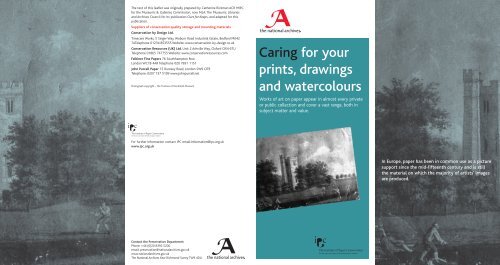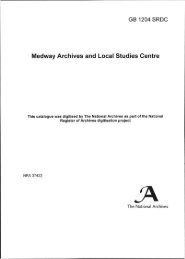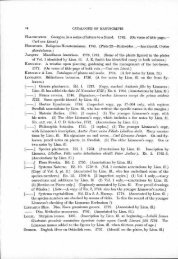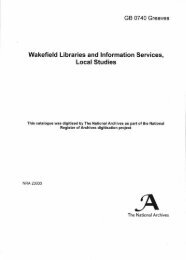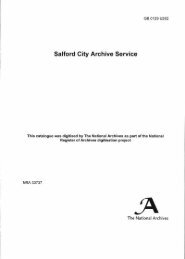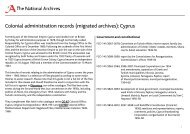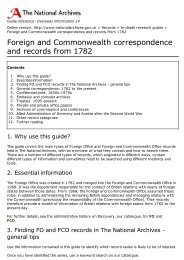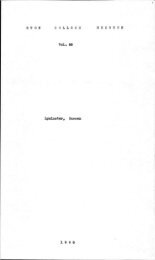Caring for your prints, drawings and watercolours - The National ...
Caring for your prints, drawings and watercolours - The National ...
Caring for your prints, drawings and watercolours - The National ...
Create successful ePaper yourself
Turn your PDF publications into a flip-book with our unique Google optimized e-Paper software.
<strong>The</strong> text of this leaflet was originally prepared by Catherine Rickman ACR MIPC<br />
<strong>for</strong> the Museums & Galleries Commission, now MLA: <strong>The</strong> Museums, Libraries<br />
<strong>and</strong> Archives Council <strong>for</strong> its publication Ours <strong>for</strong> Keeps, <strong>and</strong> adapted <strong>for</strong> this<br />
publication.<br />
Suppliers of conservation quality storage <strong>and</strong> mounting materials<br />
Conservation by Design Ltd.<br />
Timecare Works, 5 Singer Way, Woburn Road Industrial Estate, Bed<strong>for</strong>d MK42<br />
7ATelephone 01234 853555 Website: www.conservation-by-design.co.uk<br />
Conservation Resources (UK) Ltd. Unit 2 Ashville Way, Ox<strong>for</strong>d OX4 6TU<br />
Telephone 01865 747755 Website: www.conservationresources.com<br />
Falkiner Fine Papers 76 Southhampton Row<br />
London WC1B 4AR Telephone 020 7831 1151<br />
John Purcell Paper 15 Rumsey Road, London SW9 OTR<br />
Telephone: 0207 737 5199 www.johnpurcell.net<br />
Photograph copyright – the Trustees of the British Museum<br />
For further in<strong>for</strong>mation contact IPC email:in<strong>for</strong>mation@ipc.org.uk<br />
www.ipc.org.uk<br />
Contact the Preservation Department<br />
Phone: +44 (0)20 8392 5200<br />
email: preservation@nationalarchives.gov.uk<br />
www.nationalarchives.gov.uk<br />
<strong>The</strong> <strong>National</strong> Archives Kew Richmond Surrey TW9 4DU<br />
<strong>Caring</strong> <strong>for</strong> <strong>your</strong><br />
<strong>prints</strong>, <strong>drawings</strong><br />
<strong>and</strong> <strong>watercolours</strong><br />
Works of art on paper appear in almost every private<br />
or public collection <strong>and</strong> cover a vast range, both in<br />
subject matter <strong>and</strong> value.<br />
In Europe, paper has been in common use as a picture<br />
support since the mid-fifteenth century <strong>and</strong> is still<br />
the material on which the majority of artists’ images<br />
are produced.
<strong>The</strong> materials<br />
From old master <strong>drawings</strong> to contemporary <strong>prints</strong>, the paper is fundamentally<br />
made of cellulose in the <strong>for</strong>m of finely broken down plant fibres. In its purest<br />
<strong>for</strong>m, cellulose is extremely durable, but additives can cause deterioration,<br />
usually through acid degradation, which weakens the fibres.<br />
<strong>The</strong> media used on the paper may be unstable too: pigments can fade or<br />
darken, some drawing inks bleed or corrode the paper, pastels <strong>and</strong> charcoal get<br />
smudged, thick paint like oils <strong>and</strong> gouache can flake.<br />
Causes of damage<br />
Any exposure to light harms media <strong>and</strong> paper, but poor quality mounting <strong>and</strong><br />
framing damages more works of art on paper than any other agent. Prints,<br />
<strong>drawings</strong> <strong>and</strong> <strong>watercolours</strong> can be ruined through contact with unsuitable<br />
framing materials, just as they can by amateur restoration <strong>and</strong> the use of<br />
inappropriate techniques in h<strong>and</strong>ling, storage <strong>and</strong> display.<br />
Atmospheric pollutants, <strong>for</strong> example sulphur <strong>and</strong> particulates, are implicated in<br />
the destruction of paper <strong>and</strong> they can change artists’ colours too.<br />
Biological agents, like insects <strong>and</strong> mould, affect paper, but they will only<br />
flourish as a result of uncontrolled environmental factors, such as high<br />
humidity <strong>and</strong> temperature.<br />
Signs of damage<br />
Most owners of old <strong>watercolours</strong>, <strong>drawings</strong>, maps <strong>and</strong> <strong>prints</strong> are familiar with<br />
the disfiguring brown spots called ‘foxing’. <strong>The</strong> stains are caused by bacteria or<br />
mould which generally grows on acidic paper when the humidity is high, or<br />
when metallic particles from the paper making process become embedded in<br />
the fibres.<br />
A foxed watercolour by Edward Barnard<br />
Watercolour by JMW Turner showing fading of pigments where exposed to light<br />
Paper will turn brown <strong>and</strong> brittle when cardboard containing unpurified<br />
woodpulp is pressed against it <strong>and</strong> that is how so many framed works of art<br />
on paper are damaged. <strong>The</strong>y are stained on the back <strong>and</strong> have a brown or<br />
orange line around the edge of the image where the acidic overmount has<br />
‘burnt’ the paper.<br />
Yellow stains on paper, especially in regular patches, can be due to glue or<br />
adhesive tapes used to fix the picture into a mount. Self-adhesive tapes are<br />
particularly damaging because the adhesive creeps into the paper <strong>and</strong><br />
becomes impossible to remove.<br />
Too much light is usually to blame when you see a watercolour painting with a<br />
strange colour balance, or an ink drawing, which has lost its detail. <strong>The</strong> original<br />
colouring can often be found under the mount.<br />
A certain amount of cockling or undulation is usual in h<strong>and</strong>made paper, but if<br />
the work of art is badly distorted, bowing towards the glass in a frame <strong>and</strong><br />
perhaps wrinkled or even torn at the corners, then it is probably stuck down<br />
around the edges. Paper moves naturally in response to changes in humidity<br />
<strong>and</strong> it is better not to restrain it.<br />
What you can do<br />
Storage <strong>and</strong> display<br />
<strong>The</strong> best way to keep most <strong>prints</strong>, <strong>drawings</strong> <strong>and</strong> <strong>watercolours</strong> is in a specially<br />
designed case called a Sol<strong>and</strong>er box. <strong>The</strong> works of art are mounted in<br />
conservation quality materials, or placed individually in acid-free paper folders,<br />
<strong>and</strong> protected from light <strong>and</strong> dirt by the box. Plastic sleeves are not suitable<br />
but translucent acid-free tissue paper is good <strong>for</strong> interleaving or wrapping small<br />
items. Boxes, folders <strong>and</strong> portfolios, which are all obtainable fabricated from<br />
conservation quality materials, must rest horizontally in drawers or on shelves.<br />
When h<strong>and</strong>ling the work of art, you should touch the paper as little as possible<br />
<strong>and</strong> keep <strong>your</strong> fingers away from the image. Pastel <strong>and</strong> charcoal <strong>drawings</strong> need<br />
extra care because the image may offset or smudge with the slightest<br />
pressure, so you could consider keeping them permanently framed within a<br />
mount that has been rebated to prevent any static or friction. Contemporary<br />
<strong>prints</strong> should not be h<strong>and</strong>led directly either, because their immaculate paper is<br />
easily marked with skin oil <strong>and</strong> moisture. Keep them in a mount or acid-free<br />
paper folder. Artsorb is a good barrier material from atmospheric pollutants or<br />
fluctuations in RH.<br />
Protect framed <strong>prints</strong>, <strong>drawings</strong> <strong>and</strong> <strong>watercolours</strong> from daylight. Particularly<br />
avoid south facing light <strong>and</strong> try not to hang them directly against the interior<br />
of the outside wall of a building: the comparatively low temperature can cause<br />
condensation <strong>and</strong> mould growth inside a frame. Conversely, a radiator or<br />
spotlight will dry the air out, <strong>and</strong> incidentally concentrate dirt by convection<br />
currents. When choosing a suitable storage area, avoid damp cellars <strong>and</strong> uninsulated<br />
attics.<br />
If <strong>prints</strong> <strong>and</strong> <strong>drawings</strong> get really wet, <strong>for</strong> example from a burst pipe, it is better<br />
to lay them out separately on blotting paper to dry with good air circulation,<br />
rather than to use an artificial heat source. In the case of a serious flood or a<br />
fire,get help from a conservator as soon as possible.<br />
Mounting <strong>and</strong> framing<br />
If you have been to a picture framer recently, you may already know that<br />
many now offer mounting <strong>and</strong> framing to ‘conservation st<strong>and</strong>ards’. But you<br />
also need to know that these st<strong>and</strong>ards are not yet universally agreed or<br />
applied. You will still have to specify exactly what you want to safeguard<br />
<strong>your</strong> works of art. Ask the framer to follow the advice in the Institute of<br />
Paper Conservation leaflet, Guidelines <strong>for</strong> Conservation Framing, <strong>and</strong> explain<br />
that you are looking <strong>for</strong> positive answers to these five questions. Use UV<br />
protected glass.<br />
• Will both the front <strong>and</strong> the back of the mount be made of solid core 100%<br />
cotton board (known as ‘museum board’), which is the best quality, or<br />
purified woodpulp board (known as ‘conservation board’)?<br />
• If there is no window or overmount, will the glazing material be spaced<br />
away from the picture surface?<br />
• Will the work of art be attached to the backmount only with acid-free paper<br />
hinges <strong>and</strong> a water-soluble adhesive?<br />
• Will there be an isolating layer between the backmount <strong>and</strong> a potentially<br />
damaging but necessary frame backboard, made of plywood or hardboard<br />
<strong>for</strong> example?<br />
• Will the frame itself have enough depth in the rebate to accommodate the<br />
mount, the isolating layer <strong>and</strong> the backboard <strong>and</strong> strength to take hanging<br />
fittings secured to the frame <strong>and</strong> not the backboard?<br />
• If you are not confident that the framer can meet these st<strong>and</strong>ards, ask a<br />
paper conservator to help you find one who can.<br />
What you can’t do<br />
When it is too late <strong>for</strong> preventive conservation <strong>and</strong> the damage is already<br />
done, there is little that you as a collector can do to conserve <strong>and</strong> restore<br />
works of art on paper. Traditional remedies such as bread crumbsbreadcrumbs<br />
to clean off dirt <strong>and</strong> commercially produced tapes to repair tears will do more<br />
harm than good.<br />
Contact a paper conservator through the Institute of Paper Conservation <strong>and</strong><br />
they will advise on the most appropriate treatment <strong>for</strong> <strong>your</strong> picture. With<br />
professional treatment, the condition of the paper <strong>and</strong> image can be stabilised<br />
so that their deterioration will not progress. Although faded colours cannot be<br />
restored to their original brightness <strong>and</strong> severe paper staining may only be<br />
reduced, most damage can be corrected by a skilled conservator.<br />
Finding a conservator<br />
IPC operates a professional accreditation scheme to protect the users of<br />
conservation services, whether individuals or large public institutions. <strong>The</strong><br />
scheme is run in partnership with other conservation bodies. Accredited<br />
members are designated as ACR MIPC.<br />
IPC supplies free of charge, the names <strong>and</strong> addresses of ACRs either by<br />
geographical area or particular expertise. This service is open to both<br />
individuals <strong>and</strong> institutions, <strong>for</strong> a single item or collections. ACRs may also<br />
give advice on preventive conservation, disaster planning, storage <strong>and</strong> display.<br />
<strong>The</strong> Institute of Paper Conservation is the leading organisation devoted solely<br />
to the conservation <strong>and</strong> care of paper, books <strong>and</strong> related materials.<br />
<strong>The</strong> Institute of Paper Conservation e mail: in<strong>for</strong>mation@ipc.org.uk<br />
website: www.ipc.org.uk<br />
<strong>The</strong> recommendations in this leaflet are intended as guidance only. IPC does<br />
not assume responsibility or liability.<br />
An 18th c English banknote adhered to acidic board <strong>and</strong> stained by tape<br />
adhesive<br />
Photograph copyright – the Trustees of the British Museum


